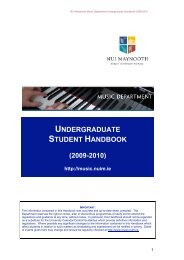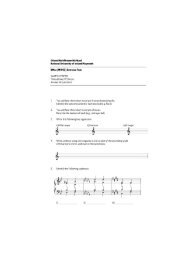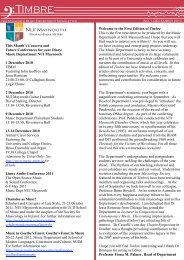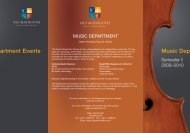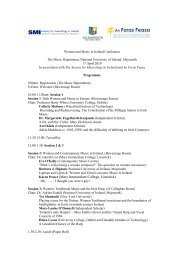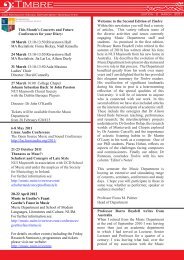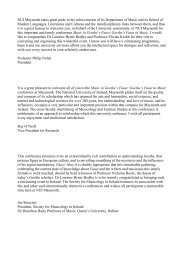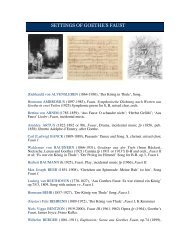Conference Booklet - Music - National University of Ireland, Maynooth
Conference Booklet - Music - National University of Ireland, Maynooth
Conference Booklet - Music - National University of Ireland, Maynooth
You also want an ePaper? Increase the reach of your titles
YUMPU automatically turns print PDFs into web optimized ePapers that Google loves.
Laura Tunbridge (<strong>University</strong> <strong>of</strong> Manchester)<br />
Against Late Style: Schubert’s ‘Ständchen’, D957 no.4<br />
‗For all the infinite sentimental abuse to which ‗Ständchen‘ has been treated, the heart <strong>of</strong> the<br />
piece – its hope even in the face <strong>of</strong> the hopeless – remains pure and strong.‘ Critic James Rovi‘s<br />
attempt to salvage the reputation <strong>of</strong> the fourth song from Schubert‘s Schwanengesang indicates<br />
the extent to which, these days, late style is equated with enhanced aesthetic worth. ‗Hope in<br />
the face <strong>of</strong> the hopeless‘, purity, strength, are qualities we now associate with the best <strong>of</strong><br />
Schubert‘s last works.<br />
But what <strong>of</strong> the ‗infinite sentimental abuse‘ to which Rovi refers? His main objection is to<br />
Lilac Time (1934), a popular biopic <strong>of</strong> Schubert, which takes ‗Ständchen‘ as its theme tune and<br />
features what seems to be a particularly hammy performance <strong>of</strong> the song by Richard Tauber<br />
impersonating Schubert at the piano. We might add to Rovi‘s list <strong>of</strong> ‗sentimentalizers‘ Germanlanguage<br />
biopic Leise flehen meine Lieder (1933), where ‗Ständchen‘ becomes the love theme for a<br />
youthful Schubert and a Countess. We can object that both these films play fast and loose with<br />
history. We might also ask whether we are doing something similar by filtering our<br />
understanding <strong>of</strong> Schubert through the lens <strong>of</strong> a late style determined primarily by twenty -firstcentury<br />
values. Even before Lilac Time and Leise flehen meine Lieder were released ‗Ständchen‘<br />
was among the most performed <strong>of</strong> Schubert‘s Lieder. There was no acknowledgment that it was<br />
a late work, simply that it was a singable one. Mainly through the example <strong>of</strong> the performance<br />
history <strong>of</strong> ‗Ständchen‘, but also with reference to works by other composers (Beethoven,<br />
Schumann), this paper investigates whether popularity and late style are mutually exclusive. It<br />
also considers whether, by arguing for late style, musicologists help audiences engage with<br />
Schubert‘s music.<br />
John Sienicki (Michigan, USA)<br />
The Posthuman Schubert: Reading Winterreise as Far Ahead <strong>of</strong> Its Time<br />
It has long been well known that Schubert <strong>of</strong>ten reused or reworked his own works in new<br />
contexts. But in the last months <strong>of</strong> his life, there was a notable increase in Schubert‘s use <strong>of</strong> the<br />
practice <strong>of</strong> ―sampling‖ <strong>of</strong> excerpts from other composers: in the E-flat Trio (a Swedish song),<br />
‗Auf dem Strom‘ (Beethoven), the C minor piano sonata (Beethoven, Vorisek), ‗Der Hirt auf<br />
dem Felsen‘ (Wenzel Müller). This sampling phase seems to have begun with Winterreise, in<br />
which Schubert marks a striking similarity between one point in Wilhelm Müller‘s story and the<br />
crisis point in Ferdinand Raimund‘s very important play ‗Der Bauer als Millionär‘ (1826) by<br />
using transformed but recognizable musical snippets from the play‘s most memorable songs<br />
(‗Aschenlied‘, ‗Brüderlein fein‘) in ‗Der greise Kopf‘ and ‗Die Krähe‘.<br />
Schubert left very little in the way <strong>of</strong> letters or statements from which to deduce his<br />
extra-musical thoughts, so perhaps the best way to approach the question <strong>of</strong> interpreting his<br />
late use <strong>of</strong> sampling is to locate musical genres in which sampling figures prominently as a<br />
compositional technique, and that share other relevant characteristics with Winterreise.<br />
We could take that moment in ‗Der greise Kopf‘, when the protagonist thinks his hair has<br />
turned gray overnight, as one defining feature, and search for stories in which the natural<br />
progression from youth to age is distorted into something unnatural, or more broadly, stories<br />
based on unusual age or intergenerational relationships. This leads to films from India, where<br />
doctrines <strong>of</strong> reincarnation provide opportunities for inventive plots exploring unu sual<br />
interpersonal structures. The most striking Bollyw ood examples <strong>of</strong> this phenomenon – such as<br />
‗Karz‘ (‗Debt‘, 1980), and its further development into ‗Om Shanti Om‘ (2007) – tend to use<br />
quotation from other films to an extent well beyond even the Bollywood norm, reincarnating<br />
those previous works in a way that parallels the plot structure.



